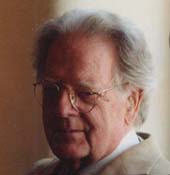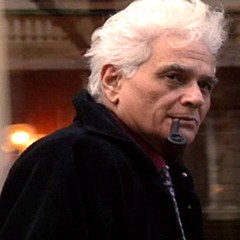As Bob Denham pointed out in his post the other day, Frye is sceptical of and occasionally hostile to post-structuralism generally and to Derrida specifically in the notebooks, but is more conciliatory in his published work and, as we saw yesterday, in interviews. He even suggests the possibility of consensus from time to time. In the introduction to Words with Power he observes that despite the variety of critical schools on the scene there is nevertheless “an underlying consensus of attitude” that could still “progress toward some unified comprehension” of literature (xviii). What this underlying consensus of attitude might be is not entirely clear from anything Frye has to say about the matter, and it is of course easier to think of him and Derrida — who is obviously much on Frye’s mind in Words with Power — as irreconcilable. The critical vocabulary each uses only heightens the sense of opposition: Frye considers metaphor a statement of identity, Derrida a relation of differences; Frye emphasizes presence, Derrida absence; and where Frye sees language leading to kerygma, or “proclamation,” Derrida sees aporia, or “impassable path.”
Frye and Derrida do, however, have at least one very important thing in common: both reveal the radically metaphorical condition of language. Frye identifies metaphor and myth as two aspects of the same elementary phenomenon, myth being metaphor as narrative (mythos), and metaphor being myth as a pattern of verbal elements (dianoia). In The Great Code he says that myth is “implicit metaphor” because it is made up of the juxtaposition of metaphors (59). Derrida, for his part, in “White Mythology” observes that the “whole philosophical delimitation of metaphor is already constructed and worked upon by ‘metaphors’ … All the concepts which have played a part in the delimitation of metaphor always have an origin and a force which are themselves ‘metaphorical.'” (New Literary History 6, 174)
Why is it then that Derrida’s readings move in the direction of aporia and Frye’s in the direction of kerygma? The main reason seems to be that Derrida, as suggested by the quote above, is a philosopher offering a critique on the “transcendental signifieds” of the “metaphysics of presence” that make up the assertions of truth which dominate the Western philosophical tradition. Frye, by contrast, is a literary scholar whose critical principles arise from the inductive survey of literature as an imaginative verbal structure existing for its own sake. The issue for Frye is not so much an obscure metaphysics of presence as it is the conspicuous presence of metaphor. Where Derrida sees language reaching for an illusory transcendental signified, Frye perceives the principle of immanent signification which expresses archetypal human concerns whose “reality” is that they are recognizably human. This distinction between a philosophical and a literary conception of language may provide a useful perspective on the direction literary criticism has taken since Derrida’s appearance on the North American scene in the late 1960s. Relentlessly changing critical fashion has apparently consigned both Frye and Derrida to the sidelines for the time being, but these two figures nevertheless represent a great divide in literary criticism that was fully apparent about twenty-five years ago and left critical theory and practice the poorer for it.
Deconstruction may have been superseded as a go-to critical tool, but its legacy endures in the Derridian notions of absence, difference, marginality, privileging and totalization, which are hallmarks of the criticisms of gender, class, race and culture that steadily rose to prominence during the 1990s. The result is that we’ve effectively returned to the state of affairs Frye complained about more than fifty years ago in the Polemical Introduction of Anatomy of Criticism: we are surrounded on all sides by what claims to be literary criticism but which nevertheless regards literature as an allegorical expression of ideological conceptions outside of it. Literary Darwinism, anyone? This situation is especially puzzling because we might have expected that Derrida’s influence would only encourage the continued deconstruction of ideology-based criticism. But criticism, like nature, abhors a vacuum, and (about as reliably as Frye predicted) deconstruction quickly exhausted its potential and we are once again scrambling to figure out just what literature is really “about.”
At least one of Frye’s interviewers featured in yesterday’s post picks up upon the similarities Frye’s criticism has with deconstruction while also noting a major difference: deconstruction’s lack of “systematic overview.” And that’s some difference. What Frye’s criticism possesses that Derrida’s does not is a consistent awareness of universal human concerns to which literature gives urgent and recurring expression in the form of archetypes. It is what is most striking about Derrida’s response in the video posted yesterday when asked about love (while rather comically confusing love — l’amour — and death — le mort — along the way): he stumbles because love evidently has no value to him as what Frye identifies as a primary concern. The other primary concerns Frye cites are, of course, food and drink, property (i.e. tools, shelter, clothing, and everything that constitutes property in the sense of what is “proper” to human life), and freedom of movement. These universal human concerns when rendered in literature are different from ideological representations of them because literature, unlike ideology, does not provide any direct program of action or belief in order to fulfill them. What literature does provide is a polarizing vision of human life as fully realized identity at one end (archetypally, the paradisal) and as complete alienation at the other (the demonic). What we generally call “reality” lies in between and has affinities to both. Sir Philip Sidney observed in “A Defense of Poetry” — in what may be the first great insight in the English critical tradition — that “the poet never affirmeth,” but reveals what “should” or “should not” be. It is clear that Sidney’s “should” and “should not” in a literary context do not merely refer to ideology and the compulsory requirements of belief and action it invariably prescribes, but to the visionary possibilities of human existence, including the triumph of life over death, plenty over impoverishment, love over enmity, and so on.
Literature does not tell us how to achieve these things. It only reminds us that they are what we wish to achieve and then leaves it up to us to adapt our ideologies and our behavior accordingly. Because we never fully accomplish this, one of the principal social uses of literature is to recreate the metaphorical expression of primary concerns in a specific historical and cultural setting. In this way literature confronts its audience with an imaginative vision of primary concerns that have not yet been fulfilled, and — because the imaginative is also existentially concerned — it always possesses the potential to recreate the social conditions that will foster such fulfillment. As Frye succinctly observes, any work of literature “will reflect the secondary and ideological concerns of its time, but it will relate those concerns to the primary ones of making a living, making love, and struggling to stay free and alive” (WP 42). This visionary recognition and response Frye, again, calls kerygma — in effect, the proclamation of the primacy of primary concern — which is an intensified awareness of our sustained participation in an ongoing act of recreation in which the infinite is always here and the eternal is always now; in which the dead, the living, and the unborn are revealed to be members of a single community of shared concern. It is, in other words, the realization of the spiritual dimension of our otherwise mortal existence. (I defer of course to the much more nuanced reading of kerygma offered by Bob Denham and Michael Dolzani, but kerygma ought to be comprehensible even in this rendering as the work we seek to do in our lifetimes that will provide for a better world we will likely never see but which we keenly desire to come into existence by our efforts.)
Frye’s resistance to deconstruction in his published remarks is therefore typically lucid. Here he is in his 1986 TLS review of Paul de Man’s posthumously published The Rhetoric of Romanticism:
[A]n ideology expresses secondary and derivative human concerns, and…what ideologies are derived from is mythology, which expresses the primary desires of existence, along with the anxieties attached to their frustration. The real object of deconstruction, then, is to reveal the mythological basis under the ideology [emphasis mine]… I doubt that this is really so far from de Man’s view, whatever his visceral reaction to the word myth would have been. I introduce the point because ideology is always nostalgic for the past or expectation of the future, or both, whereas mythology transposes everything into a present directly confronting the reader.
Again, in place of deconstruction’s “originary absence” in the metaphysics of presence, Frye reveals the presence of metaphor. Identity, which is the essence of literary metaphor (“A is B,” “love is a rose,” “a man and a woman and a blackbird are one”), manifests the underlying consensus of attitude that Frye alludes to in the introduction to Words with Power. For Frye, literary criticism in all its forms is the extension of the possibilities of literary metaphor. And the fact of human expression by way of metaphor is, in the language of deconstruction, “always already” a recreation of human concern. We need only attain sufficient critical awareness to recognize as much, at which point we begin to realize the ideal literature uniquely expresses; and that is, as Frye puts it in The Educated Imagination, to build paradise and to enter it at the same time.


